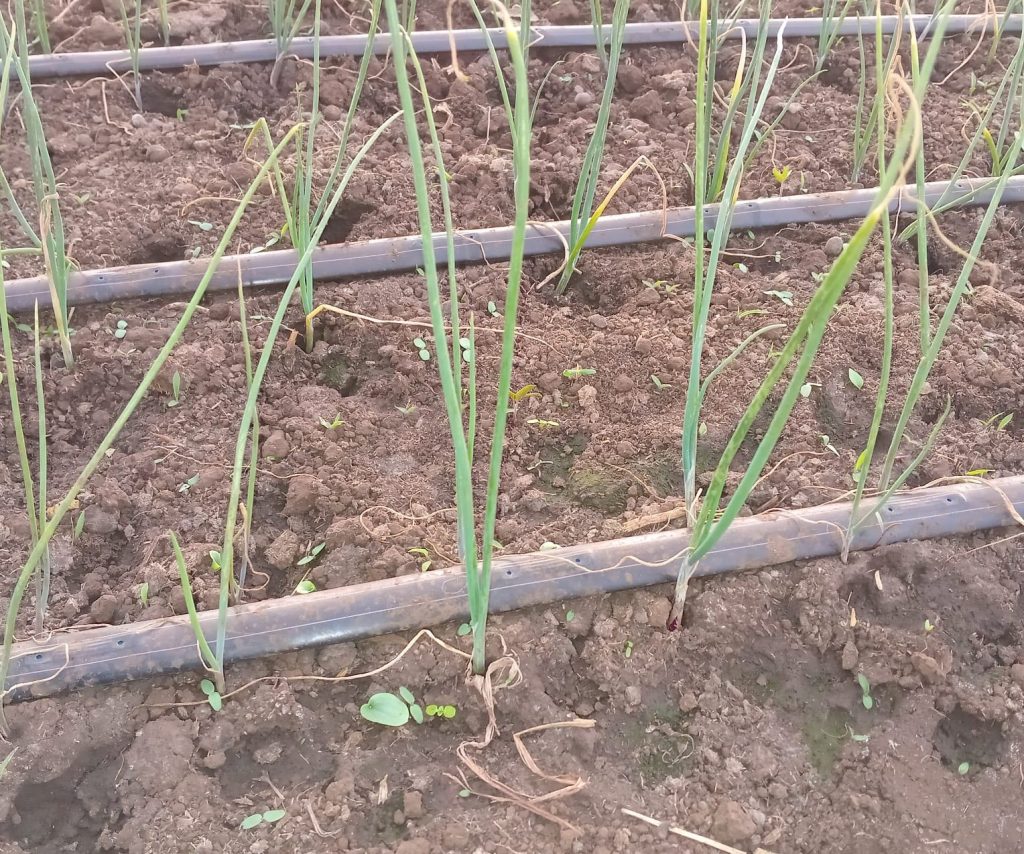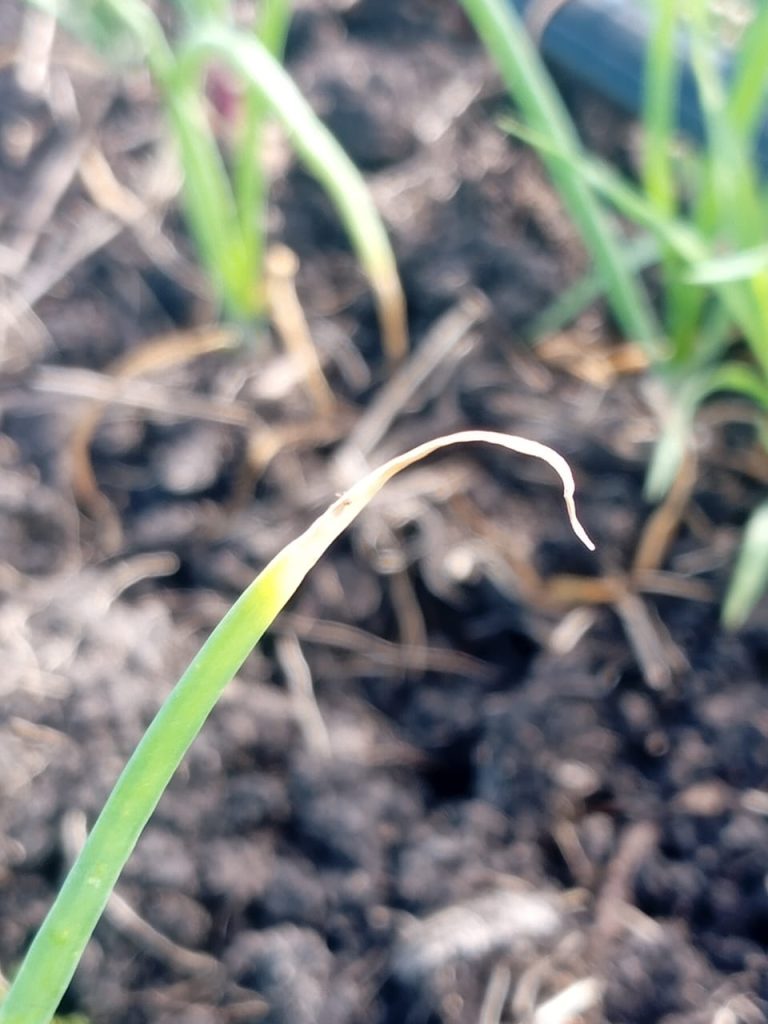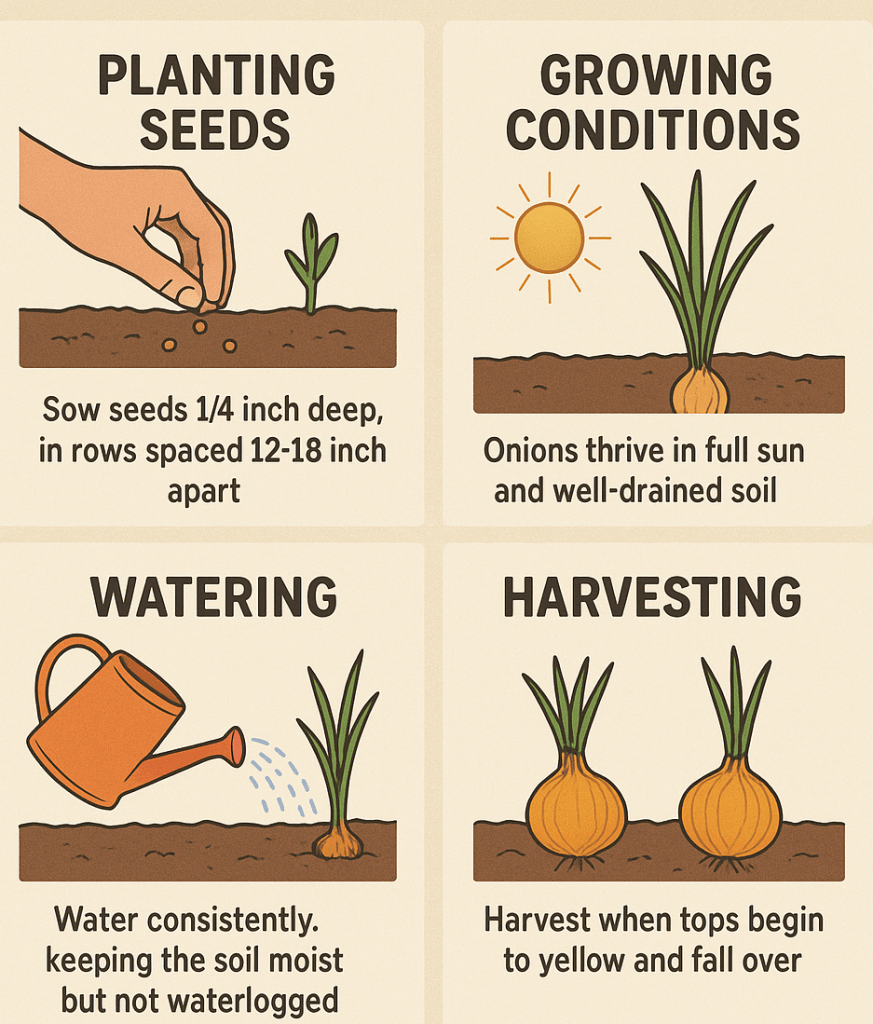Welcome to the Onion Doctor blog, where we peel back the layers on all things onion! If you’re a beginner gardener itching to grow your own onions, you’ve come to the right place. Growing onions from seed to harvest is easier than you think, and it’s a rewarding adventure that turns your backyard into a flavor factory. Whether you’re dreaming of Red Coach bulbs for salads or white onions for grilling, this guide will walk you through every step with tips, tricks, and a dash of humor to keep things fun. Let’s dive in and get growing—onion style!

BENEFITS OF ONION FARMING:
1. High Demand & Good Market Value
- Onions are a staple in almost every cuisine worldwide.
- They have consistent demand year-round, making them a reliable cash crop.
2. Long Shelf Life
- When cured and stored properly, onions can last for months, reducing post-harvest losses.
3. Multiple Varieties & Uses
- Can be consumed fresh, cooked, pickled, or dried into powder.
- Different varieties suit different climates and market preferences.
4. Nutritional & Health Benefits
- Rich in vitamins (C, B6), minerals, and antioxidants.
- Known for boosting immunity, aiding digestion, and having anti-inflammatory properties.
5. Adaptability & Ease of Cultivation
- Can be grown in various soil types and climates with proper care.
- Require relatively small land space compared to their yield potential.
6. Value Addition Opportunities
- Farmers can make onion powder, paste, or dehydrated onions for extra income.
7. Pest & Disease Management Knowledge Transfer
- Growing onions improves farm skills, as they teach farmers about soil care, irrigation, and pest control—skills transferable to other crops.

CHOOSING THE PERFECT ONION VARIETY:
1.WARM&HOT LOWLAND AREAS:
(e.g., Mwea, Kajiado, Kitui, parts of Machakos, Taveta)
- Red Creole – Heat tolerant, deep red color, long storage.
- Bombay Red – Popular in markets, early maturing, medium storage.
- Texas Early Grano 502 – Mild flavor, good size, high yield.
- Superex – Sweet, good for salads.
Why?
- These varieties perform well in high temperatures and low rainfall.
- Maturity: 90–110 days.
2.COOL HIGHLANDS & UPLAND AREAS:
(e.g., Timau, Nyeri, Nakuru, Eldoret, Narok)
- Red Pinoy – Good yield, adaptable to cooler areas.
- Siberia – Stores well, tolerates cold.
- Yellow Granex – Mild flavor, medium storage.
- Hybrid Red Passion F1 – High yield, uniform bulbs, long shelf life.
why?
- Intermediate-day varieties thrive here with cooler temperatures and well-drained soils.
- Maturity: 110–130 days.
3.SPECIAL HYBRID VARIETIES( FOR BOTH WARM &COOL ZONES:
- Neptune F1 – High yield, excellent storage.
- Red Coach F1 – Uniform bulbs, good market appeal.
- Jambar F1 – Disease resistant, high yields.
- Tropicana F1 – Performs well in multiple regions.

STARTING ONION FARMING FROM SEEDS:
Starting from seed is like nurturing baby onions—it’s hands-on and super satisfying. Begin indoors 8-10 weeks before your last spring frost (late winter for most folks).
- Gather Supplies: Use seed trays, quality seed-starting mix, and onion seeds. Aim for a warm spot with grow lights if natural sun is scarce.
- Sow the Seeds: Plant 1/4 to 1/2 inch deep, spacing them 1/2 inch apart. Keep soil moist but not soggy—think damp sponge, not swimming pool.
- Germination Magic: Seeds sprout in 7-10 days at 70-75°F. Once they reach 5-6 inches, trim the tops to 3-4 inches to encourage sturdy roots.
- Harden Off: A week before transplanting, introduce seedlings to outdoor conditions gradually to toughen them up.

TRANSPLANTING AND PLANTING:
Once the seedlings have germinated , it’s go time!
- Site Prep: Choose full sun (6+ hours) and well-draining soil with pH 6.0-6.8. Amend with compost for fertility—onions love loose, nutrient-rich dirt.
- Spacing: Plant 4-6 inches apart in rows 12-18 inches wide. Bury seedlings 1/2-1 inch deep; for sets, just cover the roots with the tip peeking out.
Mulch with straw to keep weeds down and moisture in—your onions will thank you by bulking up nicely.

CARING FOR YOUR ONION CROP: WATER AND WEED:
Onions aren’t divas, but they need consistent TLC to avoid bolting (premature flowering—boo!).
- Watering: Give 1 inch per week, more in heat. Keep soil evenly moist, especially during bulb formation, but don’t drown them to prevent rot. Use Onion Doctor`s Drip Irrigation Kits.
- Fertilizing: Use a balanced organic fertilizer every few weeks, high in nitrogen early on. Switch to low-nitrogen once bulbs swell. Contact Onion Doctor for their spray and Feeding program to ensure a successful onion harvest.
- Weeding: Hand-pull weeds carefully—onions have shallow roots. Mulch helps here too.
- Companions: Plant with carrots, tomatoes, or herbs to deter pests naturally.

COMMON ONION PROBLEMS AND HOW TO HANDLE THEM:
Every garden has hiccups, but here’s how to handle them:
- Pests: Thrips (tiny suckers) or onion maggots? Use insecticidal soap or row covers. Onions naturally repel many bugs, so they’re low-pest.
- Diseases: Downy mildew or rot? Rotate crops, ensure good airflow, and choose resistant varieties.
- Bolting: Caused by cold snaps or drought—keep conditions steady.
- Small Bulbs: Too much shade or crowding? Space properly and provide full sun.

HARVEST YOUR ONIONS:
Harvest time is the payoff! Pull when tops yellow and flop over (3-5 months from planting).
- Timing: Mid-summer for spring plants. Loosen soil and lift gently.
- Curing: Dry bulbs in a shady, ventilated spot for 7-10 days—garage or porch works.
- Storage: Trim roots and tops, store in a cool, dry place (40-60°F). Braided onions look rustic and last months!

WRAPPING IT UP:
There you have it—the ultimate beginner’s guide to growing onions from seed to harvest. With patience and these tips, you’ll be harvesting basketfuls in no time. Remember, gardening is about the journey (and the puns), so don’t sweat the small stuff. Got questions? Drop a comment below—we’re here at Onion Doctor to help you grow! Happy planting, and may your onions always be tear-free.

Contact us for: Onion seedlings, Garlic seedlings, Germinated garlic cloves, Farm planning services, Soil testing, training on onion and garlic growing, Drip irrigation installation and maintenance, Agronomic support, Onion and Garlic value pack and Farm management. For free consultation, placing orders or booking a visit with an agronomist, please contact us via Call or what’s app +254703982228, Email: Info@oniondoctor.co.ke. You can also check out our social media handles for daily updates on TikTok: https://www.tiktok.com/@oniondoctorke?_t=ZM-8wmsTu0qumO&_r=1 Instagram: https://www.instagram.com/oniondoctorke?igsh=MTVoaHF3aWUydTJzaQ==Facebook:https://www.facebook.com/share/16SwgYn2dG/ Youtube:https://youtube.com/@oniondoctorke?si=u5Jnd-r0qU9UDYqL and Twitter: https://x.com/OnionDoctorKe?t=FR3JXlS_oN1vjjUgAtfyzg&s=09.